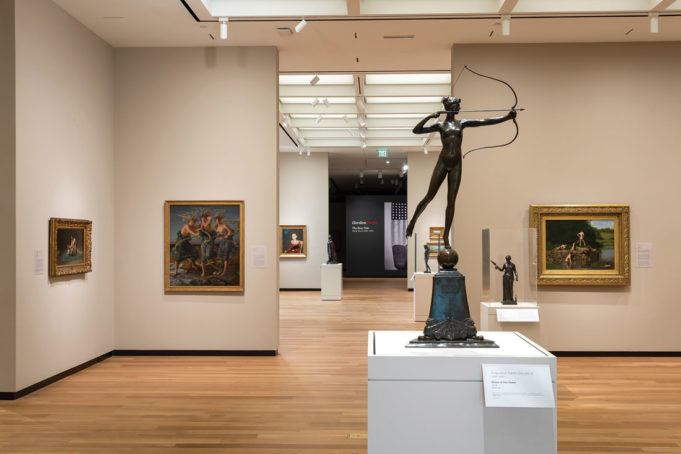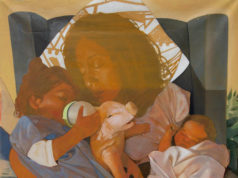The transformation this summer of the Amon Carter Museum of American Art, which closed the doors for three months, was worth waiting for.
For one, they finally got rid of the damned carpet, replacing it with American white oak wood. For another, the galleries on the second floor no longer feel like a Cold War-era bunker with a splash of color. The cavernous, claustrophobic gallery spaces have opened up, clad with white oak wood flooring, LED lighting, and modular walls, allowing for maximum use of the precious space. Creating mobile spaces opened up an extra 4,500 square feet. The soft lighting elevates the ceilings, too, creating an atmosphere for exploration.
The museum, which officially reopens on Friday, has expanded three times since opening in 1963. Each expansion added space for galleries, preservation, and storage to accompany the growing collection. Its arched exteriors have received a few facelifts, too. Those periods saw the collection grow beyond its namesake’s collection of paintings and sculptures by Charles Russell and Frederic Remington. Acquisitions include photographs, artist and institutional archives, works on paper, and paintings by historic and contemporary United States artists. The museum ultimately changed its name from “Western art” to “American art.”
But judging by the works on display, the museum’s acquisition policy more resembled Dallas Museum of Art’s take-what-you-get approach and was less methodical than its neighbors, the Kimbell Art Museum and the Modern Art Museum of Fort Worth, both of which have also expanded their footprint in recent years.
At the Carter, there was a lack of a real theme across the works on display in the permanent galleries. Each expansion failed to resolve the existential crisis since its founding. What is Western art? What is American art? How do you tell the stories and history of competing narratives – one of a conservative collector of intricate artworks portraying the rugged cowboys of the “West” chasing down indigenous people, for example, to the collection now, which includes daring photographs by women and people of color documenting the West’s flaws?
When the name changed, these questions remained: What is American art, and how do we tell that story?
Until now, the Carter told that tale poorly.
The galleries were previously divided by eras, telling a singular timeline of American art, with the Remingtons and Russells divorced from the collection on the first floor. Now, the galleries bring multiple media and centuries together around themes. On the first floor, “American Roots” tells the country’s story through new and familiar eyes. Georgia O’Keeffe’s abstract painting “Red Cannas” from 1927 is placed in front of recent works like “Discarded #29, Brawley, CA” by photographer Anthony Hernandez. In 2016, the Carter exhibited 30 of his large-scale photographs of abandoned objects, buildings, and people from the aftermath of the 2008 recession.
The new configuration also creates the experience of being in a 19th century gallery, connecting each with long vistas and connecting prominent works in the collection while still shaking up the status quo. “American Landscapes” is not just a cautious display of oil on canvas without context but allows for questions, too. “Twelve-Point Buck,” a 1999 Justine Kurland photograph of two women carrying a dead animal in the woods, is next to Thomas Cole’s “The Hunter’s Return” from 1845. The oil on canvas depicts a father and son returning from a successful hunting trip. Take their return at face value, and the two are all-American men. But next to Kurland, the women look less happy, and the result is more morbid, showing a battle between man and nature. Sometimes the humans are successful. Other times, they are not.
Each reimagined space also has considerably more room to look at and think about the works on display. They also easily flow together through “sightlines,” in the words of Maggie Adler, the curator of Western Art who formed the “Legacy Galleries” seamlessly displaying the Russells and Remingtons. (She noted people come from across the world to see the Carter’s large collection of work by both artists.)
“When you’re talking an American art museum, you don’t have to start at the dawn of art,” she said. “You’re working with certain themes in a period of time – even if an expansive period dating to indigenous periods. The changes are an articulation of how we engage the collection.”
Each gallery flows into the next with defining works. From “American Landscapes,” John Singer Sargent’s massive portrait of Edwin Booth from 1890 smacks you in the face entering “Opulence and the Every Day.” The tall and imposing portrait of the stone-faced Shakespearean actor is paired with Thomas Eakins’ “The Swimming Hole” from 1845. The result is a damning examination of the robber barons of the era’s less than opulent results during their push for industrialization.
They then all connect back to the mezzanine connecting the original, tall limestone building by the late Philip Johnson, whom the museum’s late caretaker, Ruth Carter Stevenson, frequently commissioned. The entrance of smooth Burmese teak walls between the smoothed limestone now also serves as a gallery after years of empty walls. Before closing, staff installed new shades to cover the high-tech glass, reducing ultraviolet exposure. Artwork, including a large steel and wood sculpture loaned by James Surls, who has roots in Texas, hangs from the ceiling.
“Unlike other museums, we have photographs and archives,” said Brett Abbott, the Carter’s director of collections and exhibitions, at a recent preview. “We can tell stories others can’t.”
Looking around the second floor and onto the atrium, where Gabriel Dawes’ sumptuous “Plexus No. 34” is installed, Abbott was in awe. “I feel like I’m seeing some of these works for the first time,” he added, choking up.
The changes were survey-driven and curator-designed. The result is a win for the public and curators. Both should celebrate this new era. They boldly frame how artists portray the American experience within a new lease and framework, a model for how peer institutions should move forward.













One note: Edwin Booth, the subject of Singer Sargent’s painting, was a celebrated Shakespearean actor (and the brother of Lincoln’s assassin), not an industrialist.
Small correction. The museum opened in 1961. Otherwise, fabulous story.
Nice story. Note the museum actually opened in 1961.